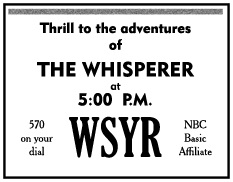
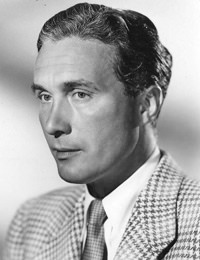 The Whisperer (1951) aired “Tea Time for Teenagers” on July 8, 1951 as the first of its 13 episodes. The man known as the Whisperer is in reality one Philip Galt, a lawyer who was in a terrible accident in which his vocal chords were crushed. He used this strange disability as a cover to infiltrate the organized crime Syndicate in Central City, passing on to the local crime affiliate their next crime or proposed illegal operation from the Syndicate’s national bosses. Upon completion of a successful operation by Dr. Benjamin Lee and his nurse Ellen Norris that returned his voice, Galt decided to continue his undercover role as the Whisperer, setting up the local Syndicate branch and then foiling their crimes and getting them arrested, convicted, and behind bars as lawyer Philip Galt. Ellen Norris is now Galt’s assistant and love interest and is the only one who knows Galt doubles as the Whisperer.
The Whisperer (1951) aired “Tea Time for Teenagers” on July 8, 1951 as the first of its 13 episodes. The man known as the Whisperer is in reality one Philip Galt, a lawyer who was in a terrible accident in which his vocal chords were crushed. He used this strange disability as a cover to infiltrate the organized crime Syndicate in Central City, passing on to the local crime affiliate their next crime or proposed illegal operation from the Syndicate’s national bosses. Upon completion of a successful operation by Dr. Benjamin Lee and his nurse Ellen Norris that returned his voice, Galt decided to continue his undercover role as the Whisperer, setting up the local Syndicate branch and then foiling their crimes and getting them arrested, convicted, and behind bars as lawyer Philip Galt. Ellen Norris is now Galt’s assistant and love interest and is the only one who knows Galt doubles as the Whisperer.
Philip Galt/The Whisperer was played by Carleton G. Young (1907-1971, photo top right). He appeared in a number of radio shows, had roles in a number of films, and did quite a few TV shows into the early 60s.
 “Tea Time for Teenagers” is a lot of fun, as you will hear. Purely by accident while doing research it hit me that “Tea Time for Teenagers” is as close to a radio version of the 1936 film Reefer Madness as you are likely to experience. Both overlap in obvious ways, including scenes, message, and the drug (marijuana) being sold. The method by which the Syndicate infiltrates a high school campus looking for a prime candidate to become the local pusher who then attempts to hook students on the drug, and the promises made to the local pusher of big money are the same. Both the 1936 film and this 1951 radio play are in essence PSAs (Public Service Announcements) warning of the dire consequences of using this gateway drug, even if the examples cited are somewhat hyperbolic and may result in slight smiles from the listening audience of today (the same effect the 1936 film had on many a pot-smoker in the 1960s and 1970s, when the counter culture was at its height and extolled the virtues of marijuana every chance they got). So settle back and enjoy an anti-marijuana cautionary tale from over 70 years ago, and reflect on how American culture and its laws have changed since the post-World War II era, when young Americans not fighting in the Korean “conflict” in 1951 might have received the message offered in “Tea Time for Teenagers.”
“Tea Time for Teenagers” is a lot of fun, as you will hear. Purely by accident while doing research it hit me that “Tea Time for Teenagers” is as close to a radio version of the 1936 film Reefer Madness as you are likely to experience. Both overlap in obvious ways, including scenes, message, and the drug (marijuana) being sold. The method by which the Syndicate infiltrates a high school campus looking for a prime candidate to become the local pusher who then attempts to hook students on the drug, and the promises made to the local pusher of big money are the same. Both the 1936 film and this 1951 radio play are in essence PSAs (Public Service Announcements) warning of the dire consequences of using this gateway drug, even if the examples cited are somewhat hyperbolic and may result in slight smiles from the listening audience of today (the same effect the 1936 film had on many a pot-smoker in the 1960s and 1970s, when the counter culture was at its height and extolled the virtues of marijuana every chance they got). So settle back and enjoy an anti-marijuana cautionary tale from over 70 years ago, and reflect on how American culture and its laws have changed since the post-World War II era, when young Americans not fighting in the Korean “conflict” in 1951 might have received the message offered in “Tea Time for Teenagers.”
Play Time: 25:32
{Airing at 5 PM on Sunday evening in early July of 1951, the neighborhood gang took the warning given in the story to heart, and while meeting at the nearby newsstand the following morning (summer vacation was in its early days) they decided to opt for uplifting adventure stories and future marvels, the sort which they had come to rely on in some of their favorite pulps. Future (combined with Science Fiction) (1950-54) was a new pulp offering colorful tales by newcomers and proven veterans alike, witness the cover stories by George O. Smith and L. Sprague de Camp featured below. It was a bi-monthly in 1951. Super Science Stories (1940-43, 1949-51) tried to hit the sweet spot between adventure and the wonders of super science, and through mostly no fault of its own and even after a second attempt, didn’t last very long. The issue shown below would be its next to last. It was a bi-monthly in 1951. Thrilling Wonder Stories (1936-55) had become a long-standing favorite with the gang, where imagination trumped scientific accuracy and didn’t blink a bug-eyed monster’s eye or think twice about it. Page-turning excitement and sense of wonder marked many of the magazine’s space-faring tales, which is one of the reasons it lasted so long when other of its brethren had disappeared from newsstand shelves, and why uncounted numbers of its stories (by many a popular author) are now considered entertaining classics and have been reprinted many times in collections over the decades. It too was a bi-monthly in 1951.}
[Left: Future SF, 7/51 – Center: Super Science Stories, 6/51 – Right: Thrilling Wonder Stories, 6/51]
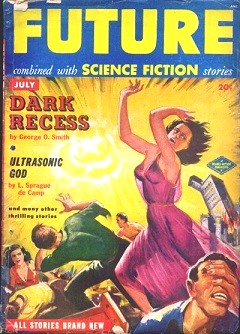
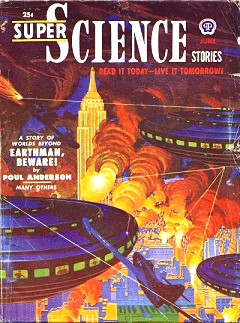
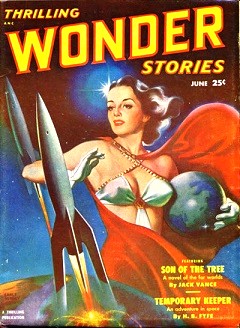
To view the entire list of Old Time Radio episodes go here.